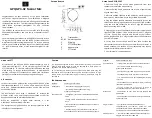
®
11
®
12
Wireless Tips
Specification
If you encounter wireless interference or dropouts, try the following suggestions:
• Replace the transmitter batteries.
• Choose a different frequency channel.
• Avoid approaching the receiver and transmitters with metal or other dense materials.
• Place the receiver as high as possible on the equipment rack.
• Remove any devices causing possible signal interference, such as cellphones, computers, media
players, two-way radios, and digital signal processors.
• Keep transmitters more than 6 feet (two meters) apart.
• Mark trouble spots during soundcheck and inform performers to avoid those areas.
• Place antennas away from each other.
ANT.4
12~15V
150mA
MIX OUT
AF OUTPUT
BALANCED 4
AF OUTPUT
BALANCED 3
AF OUTPUT
BALANCED 2
AF OUTPUT
BALANCED 1
ANT.3
ANT.2
ANT.1
X
X
X
X
—
—
+
—
X
X
X
X
X
X
ANT.4
12~15V
150mA
MIX OUT
AF OUTPUT
BALANCED 4
AF OUTPUT
BALANCED 3
AF OUTPUT
BALANCED 2
AF OUTPUT
BALANCED 1
ANT.3
ANT.2
ANT.1
X
X
X
X
—
—
+
—
X
X
X
X
X
X
X
√
Troubleshooting
Specification
ISSUE
INDICATOR STATUS
CORRESPONDING SOLUTION
No sound or fain sound
No sound or fain sound
Low battery
A howling noise
(also “feedback”) from
the speaker
Receiver LCD screen off
Receiver LCD screen on
The battery indicator shows
low battery status
• Replace fresh batteries for the transmitter.
• Do not point the microphone directly to the
speaker. And increase their distance.
• Make sure the transmitter is successfully paired
up with the receiver. You can see “ ANT ” on
the receiver screen.
• Make sure the transmitter successfully transmits
audio signals. You can see “ (
(
(
ANT
)
)
) ” flashes
on the receiver screen. Otherwise, replace
batteries for the transmitter. If it does not work,
replace the transmitter. Adjust volume controls
of the receiver and speaker to propel levels.
• Make sure the DC adapter is securely plugged
into an electrical outlet.
• Make sure the receiver is powered on.
•
Overall System
Carrier frequency range
(Depends on local regulations)
Frequency Stability
Dynamic Range
Frequency response
Audio Output Level
Working distance
XLR Interface
Operafing temperature
UHF 530 - 580 MHz
0.003%
>
105dB
50Hz-18kHz
1/4” inferface: 0-500mV; XLR interface: 0-500mV
100m/328ft
0-500mV
-10℃~+50℃
•
Receiver
Output impedance
RF sensitivity
Image rejection
Spurious rejecfion
Power
Power requirement
Dimension
Weight
XLR connector: 200Ω
-105dBm
>110dB
>90dB
5W
DC 12- 15V, Current: 300mA, Extemal power adaptor
210mm × 160mm ×45mm
775g (27.3oz)
•
Handheld & Bodypack Transmitter
Modulafion Mode
Maximum Deviation
Handheld Dimension
Handheld Weight
Power Requirement
Battery Life
FM
75kHz
249mm ×51 mm (9.8 × 2 in)
306g (10.8oz) (without batteries)
2 AA alkaline batteries (for each transmitter)
At least 8 hours with original batteries included

























